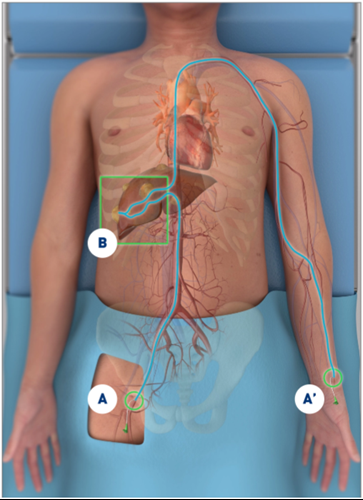SIR-Spheres® Y-90 resin microspheres
About SIRT
Selective internal radiation therapy (SIRT), also known as radioembolization, is a liver-directed therapy and is typically a two-stage process – the work-up and the treatment.
It requires the involvement of a multidisciplinary team consisting of representatives from most, if not all, of the following specialties: Medical Oncology, Surgical Oncology, Gastroenterology / Hepatology, Nuclear Medicine, Interventional Radiology/Oncology, and Radiation Safety.
SIRT targets liver tumors directly with locally applied radiation, while sparing healthy liver tissue, by using the special tumor's blood supply.
Healthy liver tissue derives about two-thirds of its blood from the portal vein, with one-fifth to one-third of the blood coming from the hepatic artery.1
In contrast, liver tumors derive up to 90% of their blood from the hepatic artery, since they need a profuse supply of highly oxygenated blood. The hepatic artery therefore provides an ideal channel for a targeted tumor treatment.
Treatment Goals
- Increase the time to progression.
- Extend overall survival.
- Potentially downsize or downstage tumors for liver resection, ablation or transplantation.
- Provide palliation of symptoms.
Administration
SIR-Spheres® Y-90 resin microspheres are administered under local anesthesia by a specially trained healthcare professional who:
- makes a small incision, either into the femoral artery near the groin (A) or the radial artery (A').
- guides a microcatheter to the pre-specified site in the hepatic artery (B) (as identified during the pre-treatment planning).
- administers SIR-Spheres through this catheter.

1. Lautt WW. Hepatic Circulation: Physiology and Pathophysiology. Morgan & Claypool Life Sciences; 2009.